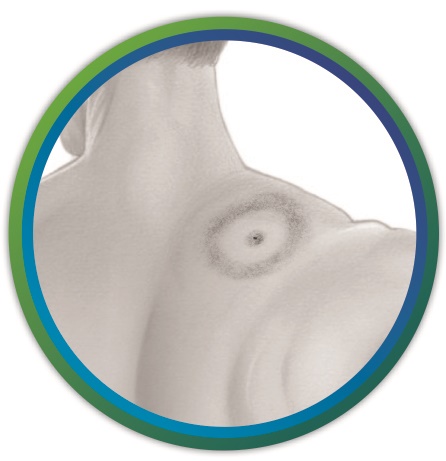Lyme Disease is the most common and widespread of tickborne diseases. 
Ticks are most likely to spread the disease between spring and summer in the Northeast. Learn more about Lyme disease and how to avoid it.
Know the Symptoms
Once infected, humans will usually develop a rash known as erythema migrans, which can look like a bull’s eye (pictured right). Flu-like symptoms are also indicative of an early infection. Other symptoms range from fatigue and joint pain to arthritis and facial palsy. If left untreated, Lyme disease can cause other long-term effects.
Prevent Tick Bites
Always take the necessary precautions to prevent ticks from biting. Wear long clothing treated with products like permethrin, and thoroughly check yourself after being outdoors
Facts & Myths
 Myth:
Myth:
If I don’t have the bull’s-eye rash, I don’t have Lyme disease.
 Fact:
Fact:
The bull’s-eye rash, also known as erythema migrans, is an early indication of infection, occurring in about 80% of people who contract Lyme disease. However, it’s only one of many symptoms of infection, and it’s still possible to develop Lyme disease from a tick bite even if you don’t end up developing this rash. Should you experience fatigue, joint pain, and/or flulike symptoms such as chills and fever, especially after being in a woodland environment or visiting endemic areas, consult your physician immediately.
 Myth:
Myth:
I don’t live in an endemic area so I shouldn’t be concerned with contracting Lyme disease or other tickborne diseases.
 Fact:
Fact:
While it’s true that people who participate in outdoor activities in endemic areas such as the Northeast should be particularly careful to avoid tick bites, it’s not true that these are the only possible areas where you can contract a tickborne disease. In fact, tickborne diseases have been reported in nearly every US state (the only exception being Hawaii).
The area of infection for tickborne diseases has nearly doubled in the last ten years, indicating a steady expansion that makes this misconception less and less true each passing year. Be sure to regularly check yourself for tick bites after spending time outdoors and contact your physician immediately should you notice a rash or other symptoms indicative of Lyme disease.
 Myth:
Myth:
I won’t be bitten by a tick outside of the spring to summer months because that is tick season.
 Fact:
Fact:
Ticks don’t simply go away because of the cold. Adult ticks carrying Lyme disease may still bite well into the fall months, and some ticks still bite in the winter. Tick season – between the spring and summer months – is simply an indication of conditions in which ticks are most likely to be active and feeding; you can very well still be bitten and contract Lyme disease outside of tick season.
 Myth:
Myth:
If I continue to experience symptoms like joint swelling and pain after the treatment, then I’m still infected with Lyme disease.
 Fact:
Fact:
Most patients with Lyme disease are effectively treated with antibiotics, especially when detected early. However, patients sometimes experience recurring symptoms for months or years following initial treatment. Unless you find evidence of another tick bite, recurrence of these symptoms alone doesn’t mean you’re still infected, and additional antibiotic treatment is unnecessary.
 Myth:
Myth:
If I’ve had Lyme disease before, I can’t contract it again.
 Fact:
Fact:
Our bodies don’t develop immunity to Lyme disease. In fact, long-term infection may leave some patients with a weakened immune system. Therefore, people who have had Lyme disease before should be extra careful to protect themselves from tick bites.

